Abstract
A major association has been found between low plasma triiodothyronine concentrations in preterm neonates and their later developmental outcome. Plasma triiodothyronine concentration was measured longitudinally in 280 preterm infants below 1850 g birth weight. Babies whose lowest recorded concentration was less than 0.3 nmol/l had, at 18 months' corrected age, 8.3 and 7.4 point disadvantages in Bayley mental and motor scales and a 8.6 point disadvantage on the academic scale of Developmental Profile II, even after adjusting for a range of antenatal and neonatal factors known to influence later development. Low concentrations of triiodothyronine were strongly associated with infant mortality, but not after adjusting for the presence of respiratory illness. There was no association between plasma triiodothyronine concentrations and somatic growth up to 18 months, and no association with necrotising enterocolitis or later cerebral palsy. Data on postnatal changes in plasma triiodothyronine concentrations are presented for reference purposes. While cited reference ranges for plasma triiodothyronine concentration appear suitable for well infants above 1500 g birth weight, smaller or ill babies often have very low values for many weeks. Our data are relevant to the debate on endocrine 'replacement' treatment in premature babies.
Full text
PDF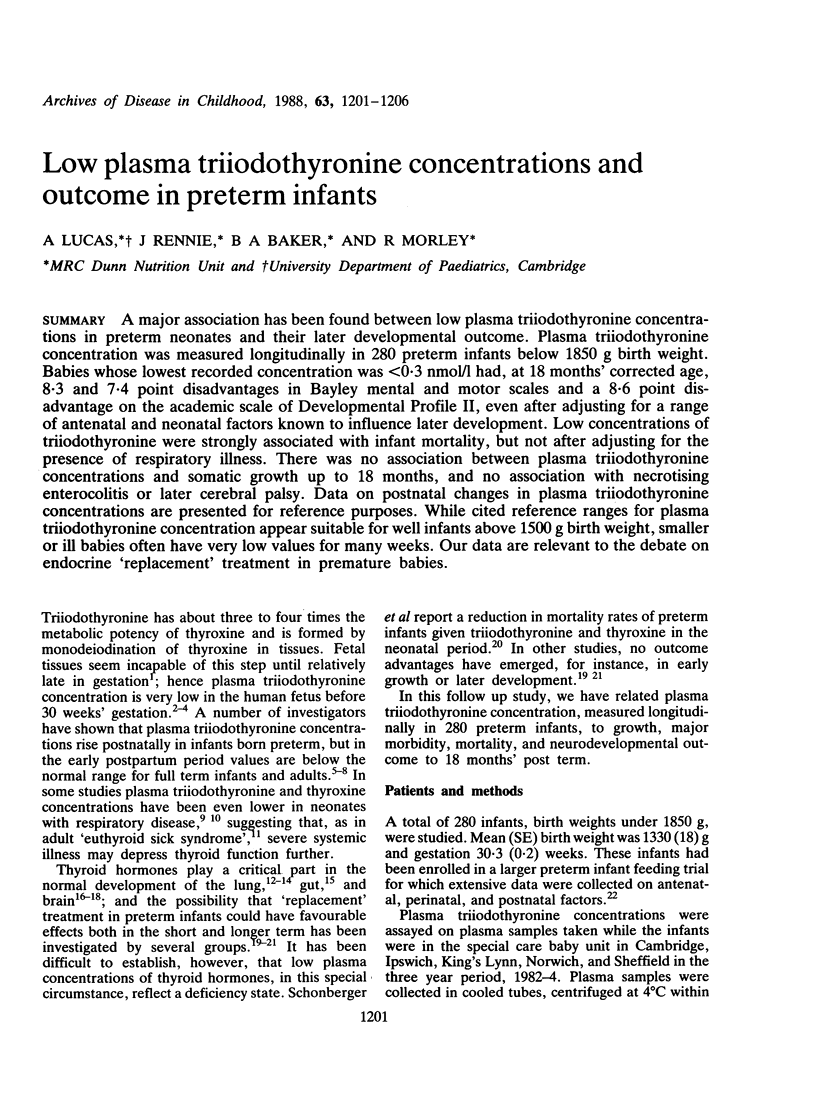
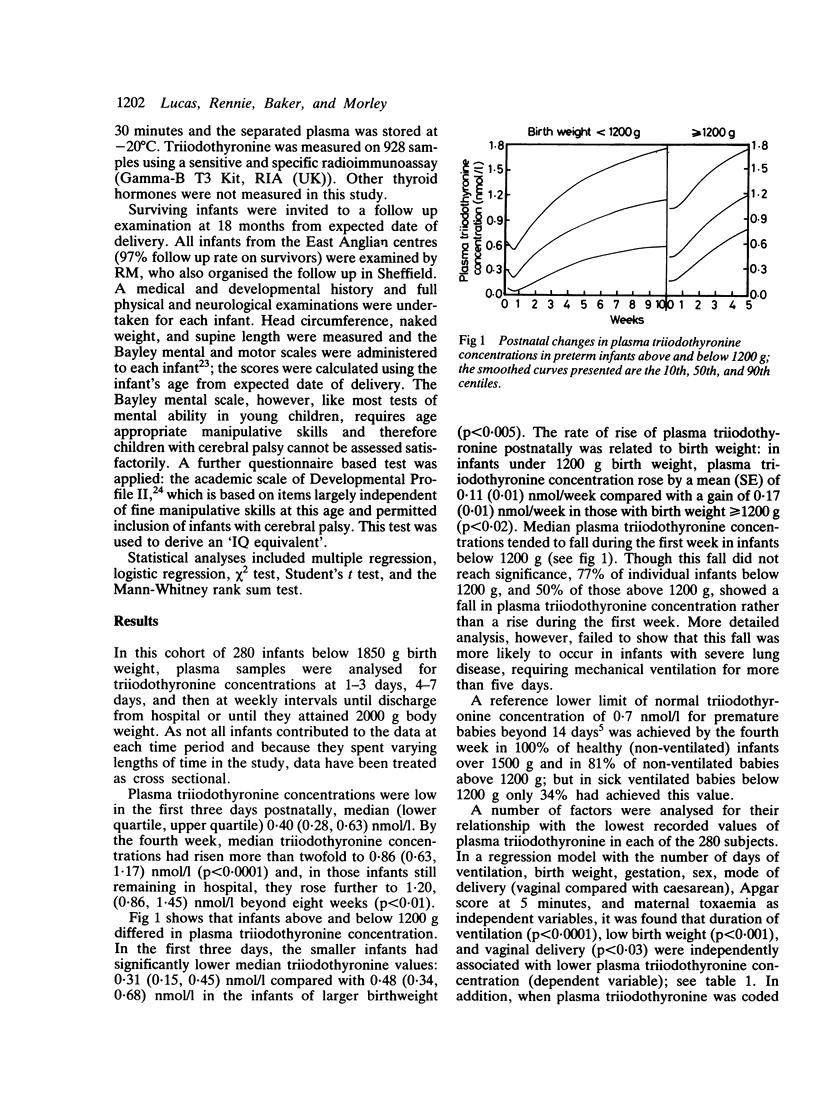
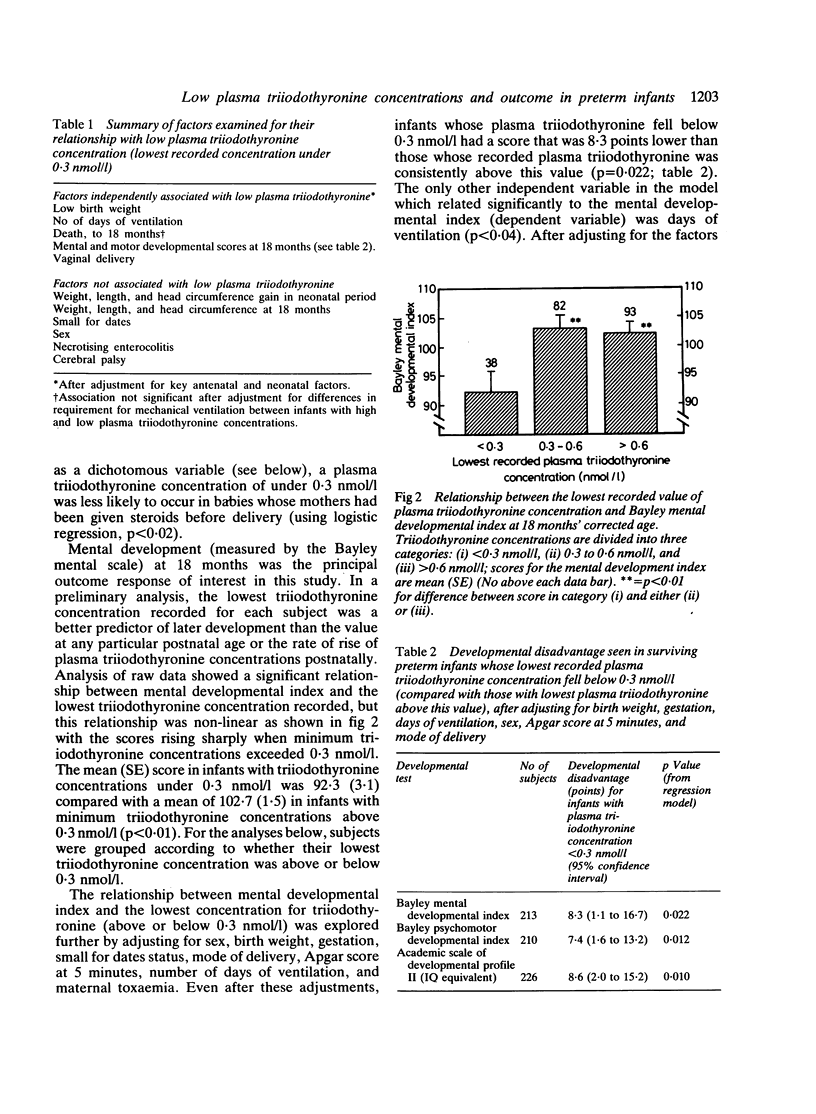
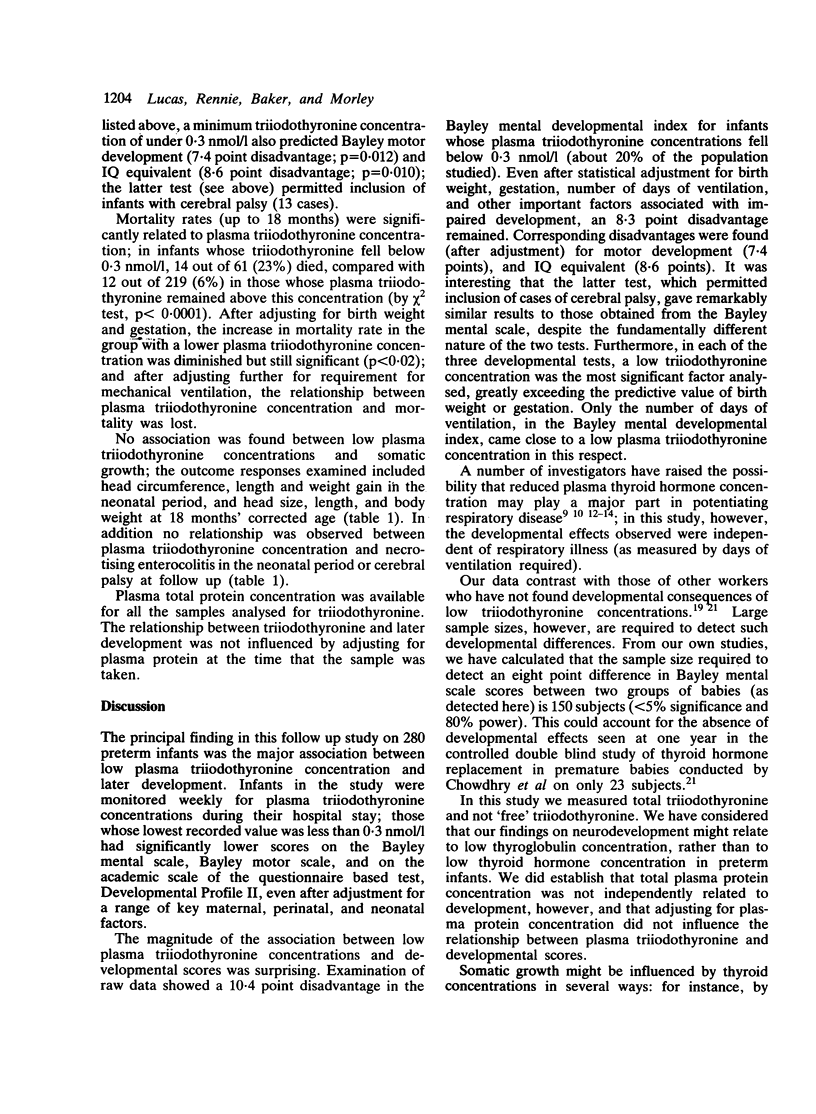
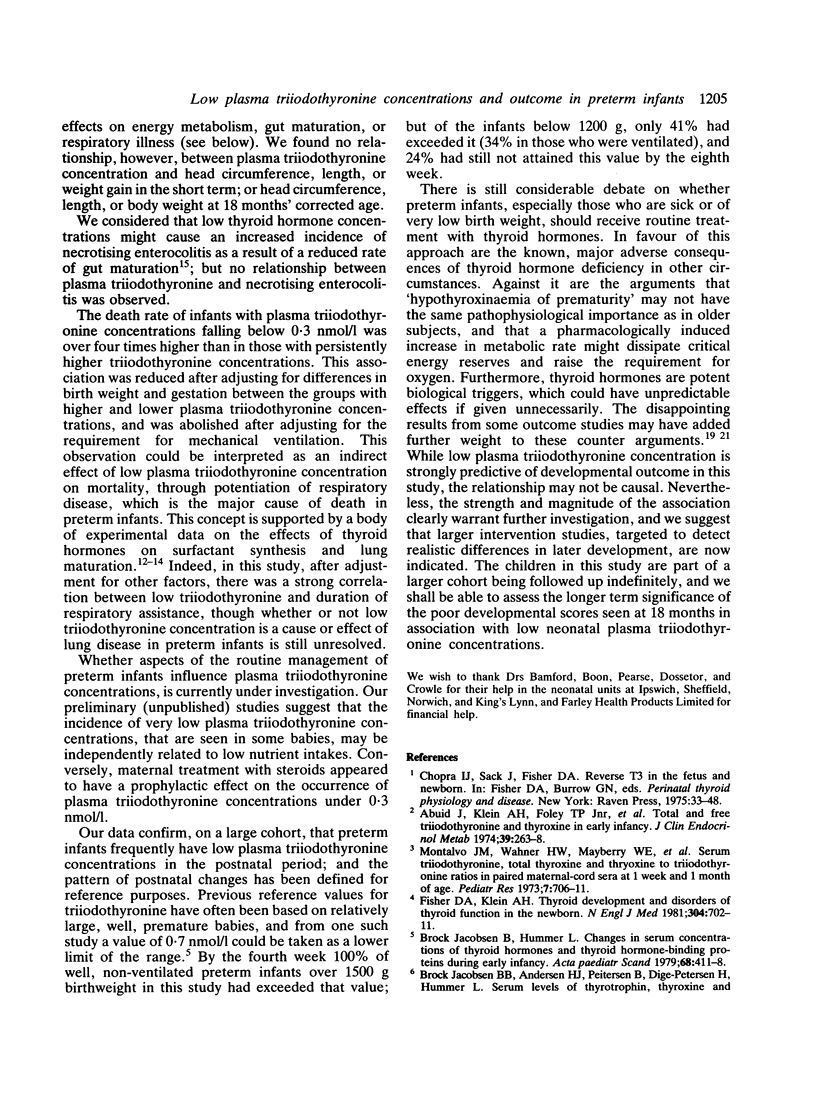
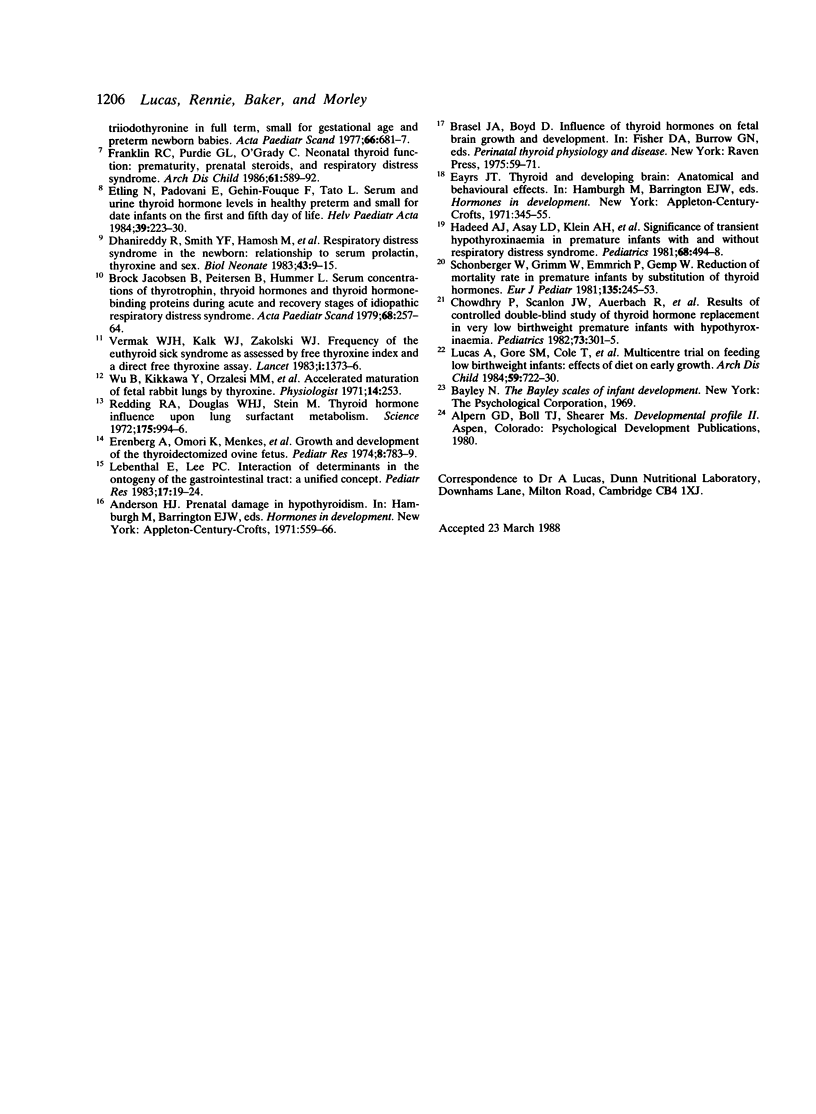
Selected References
These references are in PubMed. This may not be the complete list of references from this article.
- Abuid J., Klein A. H., Foley T. P., Jr, Larsen P. R. Total and free triiodothyronine and thyroxine in early infancy. J Clin Endocrinol Metab. 1974 Aug;39(2):263–268. doi: 10.1210/jcem-39-2-263. [DOI] [PubMed] [Google Scholar]
- Chowdhry P., Scanlon J. W., Auerbach R., Abbassi V. Results of controlled double-blind study of thyroid replacement in very low-birth-weight premature infants with hypothyroxinemia. Pediatrics. 1984 Mar;73(3):301–305. [PubMed] [Google Scholar]
- Dhanireddy R., Smith Y. F., Hamosh M., Mullon D. K., Scanlon J. W., Hamosh P. Respiratory distress syndrome in the newborn: relationship to serum prolactin, thyroxine, and sex. Biol Neonate. 1983;43(1-2):9–15. doi: 10.1159/000241631. [DOI] [PubMed] [Google Scholar]
- Erenberg A., Omori K., Menkes J. H., O W., Fisher D. A. Growth and development of the thyroidectomized ovine fetus. Pediatr Res. 1974 Sep;8(9):783–789. doi: 10.1203/00006450-197409000-00001. [DOI] [PubMed] [Google Scholar]
- Etling N., Padovani E., Gehin-Fouque F., Tato L. Serum and urine thyroid hormone levels in healthy preterm and small for date infants on the first and fifth day of life. Helv Paediatr Acta. 1984 Aug;39(3):223–230. [PubMed] [Google Scholar]
- Fisher D. A., Klein A. H. Thyroid development and disorders of thyroid function in the newborn. N Engl J Med. 1981 Mar 19;304(12):702–712. doi: 10.1056/NEJM198103193041205. [DOI] [PubMed] [Google Scholar]
- Franklin R. C., Purdie G. L., O'Grady C. M. Neonatal thyroid function: prematurity, prenatal steroids, and respiratory distress syndrome. Arch Dis Child. 1986 Jun;61(6):589–592. doi: 10.1136/adc.61.6.589. [DOI] [PMC free article] [PubMed] [Google Scholar]
- Hadeed A. J., Asay L. D., Klein A. H., Fisher D. A. Significance of transient postnatal hypothyroxinemia in premature infants with and without respiratory distress syndrome. Pediatrics. 1981 Oct;68(4):494–498. [PubMed] [Google Scholar]
- Jacobsen B. B., Andersen H. J., Peitersen A. B., Dige-Petersen H., Hummer L. Serum levels of thyrotropin, thyroxine and triiodothyronine in fullterm, small-for-gestational age and preterm newborn babies. Acta Paediatr Scand. 1977 Nov;66(6):681–687. doi: 10.1111/j.1651-2227.1977.tb07971.x. [DOI] [PubMed] [Google Scholar]
- Jacobsen B. B., Hummer L. Changes in serum concentrations of thyroid hormones and thyroid hormone-binding proteins during early infancy. Studies in healthy fullterm, small-for-gestational age and preterm infants aged 7 to 240 days. Acta Paediatr Scand. 1979 May;68(3):411–418. doi: 10.1111/j.1651-2227.1979.tb05029.x. [DOI] [PubMed] [Google Scholar]
- Jacobsen B. B., Peitersen B., Hummer L. Serum concentrations of thyrotropin, thyroid hormones and thyroid hormone-binding proteins during acute and recovery stages of idiopathic respiratory distress syndrome. Acta Paediatr Scand. 1979 Mar;68(2):257–264. doi: 10.1111/j.1651-2227.1979.tb04998.x. [DOI] [PubMed] [Google Scholar]
- Lebenthal E., Lee P. C. Review article. Interactions of determinants in the ontogeny of the gastrointestinal tract: a unified concept. Pediatr Res. 1983 Jan;17(1):19–24. doi: 10.1203/00006450-198301000-00004. [DOI] [PubMed] [Google Scholar]
- Lucas A., Gore S. M., Cole T. J., Bamford M. F., Dossetor J. F., Barr I., Dicarlo L., Cork S., Lucas P. J. Multicentre trial on feeding low birthweight infants: effects of diet on early growth. Arch Dis Child. 1984 Aug;59(8):722–730. doi: 10.1136/adc.59.8.722. [DOI] [PMC free article] [PubMed] [Google Scholar]
- Montalvo J. M., Wahner H. W., Mayberry W. E., Lum R. K. Serum triiodothyronine, total thyroxine, and thyroxine to triiodothyronine ratios in paired maternal-cord sera and at one week and one month of age. Pediatr Res. 1973 Aug;7(8):706–711. doi: 10.1203/00006450-197308000-00006. [DOI] [PubMed] [Google Scholar]
- Redding R. A., Douglas W. H., Stein M. Thyroid hormone influence upon lung surfactant metabolism. Science. 1972 Mar 3;175(4025):994–996. doi: 10.1126/science.175.4025.994. [DOI] [PubMed] [Google Scholar]
- Schönberger W., Grimm W., Emmrich P., Gempp W. Reduction of mortality rate in premature infants by substitution of thyroid hormones. Eur J Pediatr. 1981 Feb;135(3):245–253. doi: 10.1007/BF00442098. [DOI] [PubMed] [Google Scholar]
- Vermaak W. J., Kalk W. J., Zakolski W. J. Frequency of euthyroid sick syndrome as assessed by free thyroxine index and a direct free thyroxine assay. A limitation of FT4 assays. Lancet. 1983 Jun 18;1(8338):1373–1375. doi: 10.1016/s0140-6736(83)92149-9. [DOI] [PubMed] [Google Scholar]


